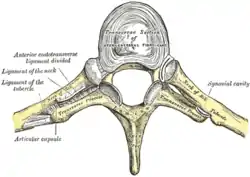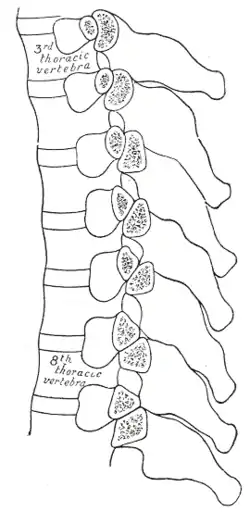Costotransverse joint
The costotransverse joint is the joint formed between the facet of the tubercle of the rib and the adjacent transverse process of a thoracic vertebra. The costotransverse joint is a plane type of synovial joint which, under physiological conditions, allows only gliding movement.
| Costotransverse articulations | |
|---|---|
 Costotransverse articulation. Seen from above. | |
 Section of the costotransverse joints from the third to the ninth inclusive. Contrast the concave facets on the upper with the flattened facets on the lower transverse processes | |
| Details | |
| Identifiers | |
| Latin | Articulatio costotransversaria |
| TA98 | A03.3.04.005 |
| TA2 | 1724 |
| FMA | 7952 |
| Anatomical terminology | |
This costotransverse joint is present in all but the eleventh and twelfth ribs. The first ten ribs have two joints in close proximity posteriorly; the costovertebral joints and the costotransverse joints. This arrangement restrains the motion of the ribs allowing them to work in a parallel fashion during breathing. If a typical rib had only one joint posteriorly the resultant swivel action would allow a rib to be non-parallel with respect to the neighboring ribs making for a very inefficient breathing.
The intercostal nerves innervate the costotransverse joints. Therefore, therapeutic medial branch blocks are ineffectual.
The ligaments of the joint are:
- Articular capsule
- Costotransverse ligament
- Posterior costotransverse ligament
- Lateral costotransverse ligament
- Superior costotransverse ligament
- Inferior costotransverse ligament
- The costotransverse ligament
- Ligament of neck of rib
- Ligament of tubercle of rib
References
![]() This article incorporates text in the public domain from page 300 of the 20th edition of Gray's Anatomy (1918)
This article incorporates text in the public domain from page 300 of the 20th edition of Gray's Anatomy (1918)